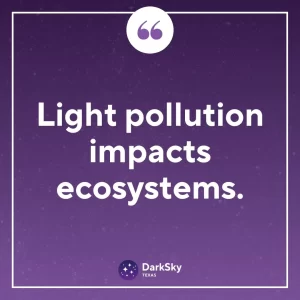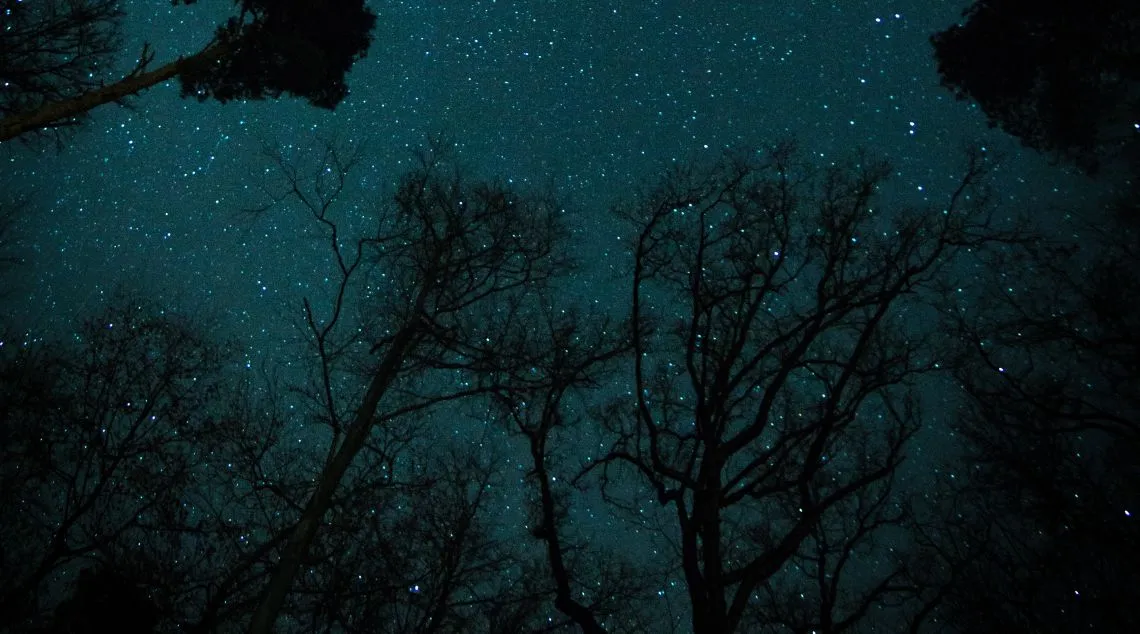DarkSky Texas talks a lot about light pollution, and one of the top questions we hear is, “How does light pollution affect the environment in Texas”? Light pollution has serious effects on the environment here in Texas and across the world. It impacts the balance within ecosystems, disrupts insect populations, drives pollinators away, disorients birds, alters the timing of sleep, and confuses plants and animals.
Light Pollution and Plants
Nighttime lights and the lack of natural dark nights can alter plant growth patterns, interfering with their natural cycles. Artificial light at night can affect plants’ perception of daytime, potentially altering their growth and metabolic activities.
Some species rely as much on their “dark cycle” as their “light cycle” to thrive or bear fruit. Other plants growing too rapidly can become invasive, affecting nearby species or encroaching upon farmland.
At the same time, the lack of dark nights disrupts insect populations, driving pollinators away.
Combining both effects can also alter plants’ seasonal cycles. This mechanism gets trees to shed their leaves as days get shorter and winter approaches. Some studies have observed that trees near street lamps or in heavily light-polluted areas tend to remain green further into the autumn. This puts them at risk of having ice or snow buildup cause their branches to break harming the tree if they don’t go to winter mode on time!
Meanwhile, several aquatic plants, such as periphyton, don’t reproduce as readily under skyglow. In rivers or lakes, this can alter the entire food chain, impacting almost every animal species in the area.
Does light pollution affect animals?
Yes. Both skyglow and direct glare can confuse, misdirect, and eventually kill local animals.
So what animals are affected by light pollution? Let’s go from big to small:

- Many insect species are naturally attracted to light. Stereotypically, moths are inevitably drawn towards light bulbs but are not alone. Mosquitos, fruit flies, and other species that require high humidity also chase the light because they’re looking for the glare of water courses. Confused, they end up far away from food or invading human habitats.
- Frogs and small reptiles also “chase” the light soon after hatching to reach the water. For example, near many sea turtle hatching sites, glare and skyglow can cause hatchlings to move away from the ocean where they quickly fall prey to local birds, small mammals, or vehicles.
- Non-migratory birds need natural darkness to properly reduce their metabolic rate at night and rest. Light entering their environment at night may cause them to avoid an area essential for their survival. Even skyglow is enough light to alter their behaviors.
- Migratory birds follow the stars and day-length patterns to cross continents back to safety. Excess light can easily get them lost or cause them to crash into windows. Skyglow and lights at night draw the migrating birds into areas where they may not have the necessary food or resources to survive.
- Glare will easily blind or disorient small mammals. Bright lights often bring them dangerously close to highways and roads, where they quickly get killed (and cause dangerous accidents).
- Many wild and domestic predators are crepuscular—they hunt at dusk and dawn. Light pollution extends their “hunting hours,” potentially allowing them to hunt other animals to near extinction.
Artificial light effects on humans
Humans spend most of their lives in daylight, requiring light to see correctly. However, our eyes can adjust to low light situations and our bodies need to spend time in darkness to rest and to recover effectively. Excessive exposure to artificial lights can alter our circadian cycle, which acts as our “internal clock.”
The circadian cycle influences our activity levels, energy, and hormone fluctuations. This is why we can now classify the effects of light pollution on humans as immediate and long-term.
Short-term artificial light effects on humans can often be felt within days of being surrounded by bright, “white” or “blue” lights after sunset. They include:
- Decreased production of melatonin, a hormone that influences sleep quality,
- Poor sleep quality leading to insomnia, sleep disorders, and daytime fatigue, and
- An increased risk of depression and anxiety.
- Chronic insomnia or sleep problems can also increase your chances of daytime accidents and poor performance at work or school.
So far, all these effects can be directly linked to poor sleep. However, some studies now suggest that the damage may go further. Insomnia, fatigue, and a near-permanent “jet lag” may also increase our risk of developing other diseases such as:
- Hormone dependent-cancers, such as breast or prostate cancers
- Obesity and diabetes
- High cholesterol and related heart disease
Now, the cause-and-effect relationship gets a little trickier when discussing long-term impact. Problems such as obesity or specific cancers are caused by many factors at once, which accumulate throughout life. This is why we’re talking about an increased risk rather than a direct cause – and yet, once we take them all together, they’re big enough to catch our attention.
What’s Next?
The last century has been the first time in history where nights stopped being dark. Many of us, who have grown to take our backyard lights for granted, can now see their full impact.
The good news is that we can start working on the solution immediately. As an understanding of light pollution gains traction, so can the measures to combat it.


